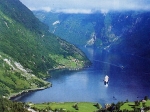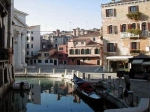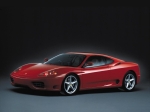
 Slovakia is a landlocked republic in Central Europe . It borders the Czech Republic in the northwest, Poland in the north, Ukraine in the east, Hungary in the south, and Austria in the southwest.
Slovakia is a landlocked republic in Central Europe . It borders the Czech Republic in the northwest, Poland in the north, Ukraine in the east, Hungary in the south, and Austria in the southwest.
Geography
The Slovak landscape is noted primarily for its mountainous nature, with the Carpathian Mountains extending across most of the northern half of the country. Amongst them are the high peaks of the Tatra mountains , which are a popular skiing destination and home to many scenic lakes and valleys as well as the highest point in Slovakia, the Gerlachovský štít at 2,655 m. Lowlands are found in the southwestern (along the Danube ) and southeastern parts of Slovakia. Major Slovak rivers, besides the Danube , are the Váh and the Hron .
The Slovak climate is temperate , with relatively cool summers and cold, cloudy and humid winters.
Economy
In a survey of the German Chamber of Commerce held in March 2004, as much as 50 percent of German enterpreneurs chose Slovakia as the best place for investment.
Slovakia has mastered much of the difficult transition from a centrally planned economy to a modern market economy. The Slovak government made progress in 2001 in macroeconomic stabilisation and structural reform. Major privatisations are nearly complete, the banking sector is almost completely in foreign hands, and foreign investment has picked up. Slovakia's economy exceeded expectations in the early 2000s, despite recession in key export markets.
Revival of domestic demand in 2002, partly due to a rise in real wages, offset slowing export growth to help drive the economy to its strongest expansion since 1998 . Solid domestic demand boosted economic growth to 4.4 percent in 2002 . Strong export growth, in turn, pushed economic growth to a still-strong 4.2 percent in 2003 , despite a downturn in household consumption.
Unemployment , rising from 14.9 percent at the end of 1998 to 19.2 percent at the end of 2001 (seasonally adjusted harmonised rate) during the radical reforms introduced by the Slovak government since 1999, decreased again to 16.6 percent at the end of 2003.
Inflation dropped from an average annual rate of 12.0 percent in 2000 to just 3.3 percent in the election year 2002, but it rose again in 2003-2004 due to necessary increases in taxes and regulated prices. Nonetheless, the CPI is widely expected to fall below 4 percent by 2005.
Slovakia would like to adopt the Euro currency in January 2009 , although the public sector deficit needs to be cut in the draft budget from its current 3.8 percent of GDP to below 3 percent in order for this to be possible.
Demographics
The majority of the inhabitants of Slovakia are ethnically Slovak (86 percent). Hungarians are the largest ethnic minority (10 percent) and are concentrated in the southern and eastern regions of the country. Other ethnic groups include Roma , Czechs , Ruthenians , Ukrainians , Germans , and Poles . The percentage of Roma is 1.7% according to the last census (that is based on the own definition of the Roma), but around 5.6% based on interviews with municipality representatives and mayors (that is based on the definition of the remaining population). Note however that in the case of the 5.6%, the above percentages of Hungarians and Slovaks are lower by 4 percentage points in sum.
The Slovak constitution guarantees freedom of religion . The majority of Slovak citizens (60.3 percent) practice Roman Catholicism ; the second-largest group consider themselves atheists (9.7 percent). About 8.4 percent are Protestants , and 4.1 percent are Greek Catholic , i.e., Eastern Catholic and some 0.9 percent are Eastern Orthodox . About 2,300 Jews remain of the estimated pre-WWII population of 120,000. The official state language is Slovak , a member of the Slavic languages , but Hungarian is also widely spoken in the south and enjoys a co-official status in some regions.




